Using visuals to help teach grammar
Sponsored advertorial by DK Learning.
Modern English Teacher, 32 (6), November/December, 2023
Creative ideas for using images in class. Sponsored advertorial by DK Learning. Written by Katherine Bilsborough.

We live in a world where visual stimuli are all around us. We are constantly interpreting and making sense of pictures. It makes perfect sense to tap into this by bringing visuals into the classroom, and using them to help teach grammar is an ideal way of making grammar learning more memorable for the learner. English for Everyone is a highly visual course using pictures and graphics to explain grammar as well as other aspects of language in a clear and engaging format. Click here or scan the QR code below for more information on English for Everyone.
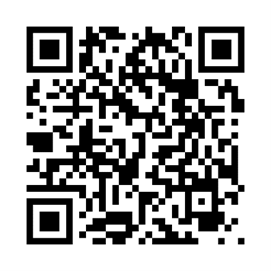
What kind of visuals can we use?
We can use drawings and illustrations, photos, all kinds of diagrams, comic strips and infographs to teach grammar. The ideal visual will depend on the activity and the kind of learners you have. Children often respond well to drawings by and photos of other children while older students are probably more used to decoding information in a more complex graphic.
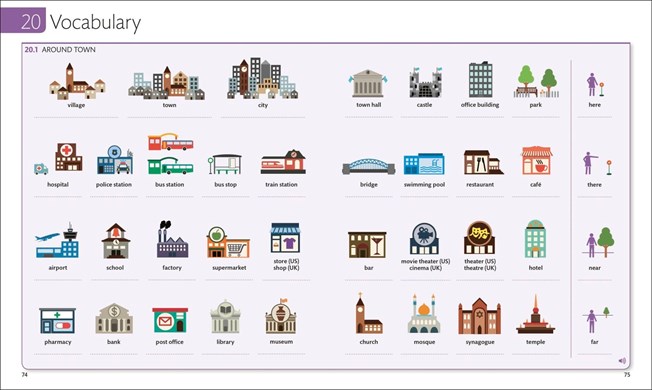
English for Everyone Course Book Level 1 Beginner
Where can we find suitable visuals?
Visuals are all around us but we need to be careful about infringing copyright laws when selecting them for our lessons. So be cautious when you select a picture to use in class and check you have permission to use it. A good place to start is with the images in the DK course materials. All the images are of a high quality and all the necessary permissions for their use have already been obtained so they are safe to use. In fact, DK’s English for Everyone Junior, is an illustrated language course for children aged six to nine with a bank of additional resources. These are highly visual and lend themselves easily to all kinds of engaging and practical activities.
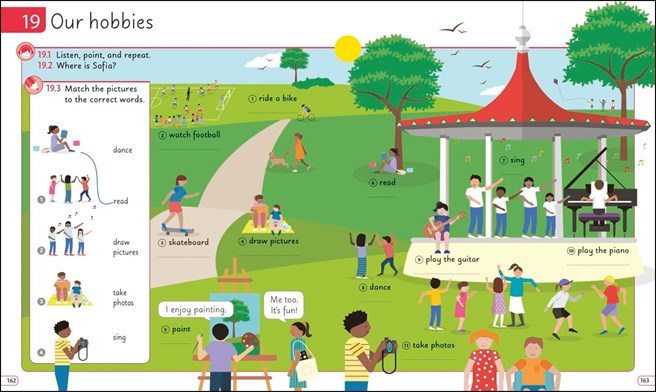
English for Everyone Junior Beginner’s Course
It is worth thinking that you can always repurpose an image and use it in a new way. This requires minimum effort and has no cost. As teachers, we can also use our own photos and drawings, or we can ask our learners to provide some too. We can also look in the many different image banks available online, though these examples can sometimes be pricey. As an alternative, you might like to check out some free stock images on websites such as Pixabay or Unsplash. Then when you embed the image into a worksheet or a slide that you create, but don’t forget to attribute the source if they aren’t your own.
Five ideas for using visuals to teach grammar
Activity 1: Yesterday!
Visual: A photo of a group of people
Grammar point: Past simple
Procedure: Show your learners a photo. Tell them to choose one of the people from the photo and imagine they are this person and that this photo was taken yesterday. Write some prompt questions on the board to help generate ideas:
- Where were you?
- How did you get there?
- Who were you with?
- What did you do? What did you see?
- How did you feel?
- What was the best thing that happened?
Then ask learners to write a short diary entry based on the photo.
Activity 2: Questions, questions, questions!
Visual: A photo of a place
Grammar point: Wh- questions
Procedure: Before the lesson, write a list of answers to Wh- questions on the board or on a slide. Show your class the photo and the answers. Explain that their task is to write questions for these answers. They might like to work in pairs so they can discuss their ideas. Explain that there might be more than one correct question and that they should use their imagination.
Suggested answers:
- In the south of Argentina.
- It’s sunny and hot.
- Last year in summer.
- A journalist working for a nature magazine.
- About sixty kilometres.
- Foxes, rabbits, mice and lots of birds and insects.
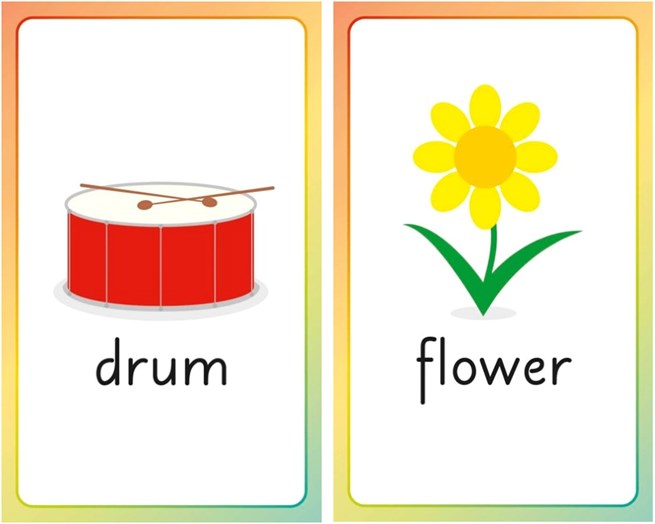
English for Everyone Junior English Alphabet Flash Cards
Activity 3: Keep the story going
Visual: A selection of cards with random pictures cut from magazines or hand drawn (Note: English for Everyone has a range of flashcards at different levels which are ideal for this activity.)
Grammar point: Narrative tenses, linking words
Procedure: Put your learners into pairs or small groups. Place the cards face down in the middle. Monitor as learners collaborate to tell a story, using the pictures as prompts. They should take turns to take a card and continue the story, building in a reference to the new picture. You can make the activity more structured by providing leaners with some language you want them to use. This might be sequencing words like then, after that, later, or examples of tenses such as the past simple, past continuous, past perfect, etc.
Note: For an online lesson, do the activity with your learners as a whole class, holding up each card in turn. Alternatively, use a slide deck with random images.
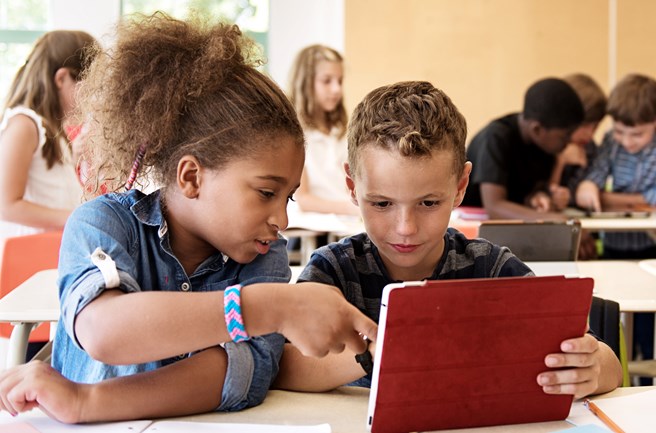
Activity 4: Listen and draw
Visual: A simple drawing
Grammar point: Prepositions of place
Procedure: Before the class, draw a simple picture on a piece of paper. Keep in mind that your learners are going to replicate the drawing, so don’t make it too complicated. A simple abstract drawing with shapes and lines works well. Make sure your learners are prepared with paper and a pencil. Then ‘dictate’ the picture, one element at a time. Learners listen and draw. Use a variety of prepositions of place and phrases such as in the middle, on the left, at the top, etc.
Extension: Put your learners into pairs, A and B. Tell A to draw a simple picture and then, without showing it to B, to dictate the picture as you did. They should use prepositions of place and other useful phrases you give them. B listens and draws but can ask questions for clarification. Then get learners to change roles and repeat the activity.
Note: This activity is good practice for describing pictures, something learners might have to do in a speaking exam but also something they might find themselves doing in English one day.
Activity 5: It could be a snail!
Visual: A photo with a missing section
Grammar point: Language for speculation
Procedure: Before the class, find a suitable photo of someone doing something or a scene with a focal point. Use a piece of coloured card to cover a key element in the photo. For example, if the photo shows some children looking at a kitten, cover the kitten so that your learners can’t see it. Ask the learners to speculate as to what the missing part of the photo is. Provide them with some useful language that you’d like them to practise, for instance:
- It might / may be a …
- It could be a …
- I think / don’t think it’s a … because …
- Perhaps it’s a …
Note: Why not ask your learners to bring in images with missing sections? They can work in groups, taking turns to share their pictures and invite their classmates to speculate.
As you collect more images for activities like the ones I have just demonstrated, why not start building up and keeping a picture bank of your own for teaching grammar? It can become a valuable teaching resource either for your own use or to share and collaborate on with others. As Charlie Macksey, author of The Boy, the Mole, the Fox and the Horse (Ebury Press, 2019) said, ‘[Pictures] are like islands, places to get to in a sea of words’.
There are also many more ideas in the DK series, English for Everyone. Click here for more information about the course or scan this QR code for quick access:
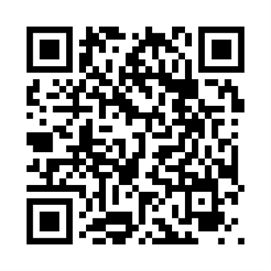
----------------------------------------------------------------------------------------------------------------
The content for this page was paid for and provided by DK Learning.
Comments
Write a Comment
Comment Submitted